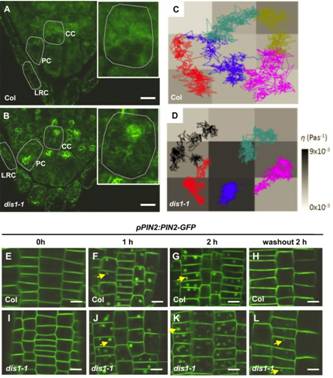Gravity is one of important environmental factors on earth. Plants have evolved specific perception and response to gravity (gravitropism), such as the positive gravitropism (downward growth into soil) of roots and negative gravitropism of shoots (upright growth) during plant development and morphogenesis are important for the efficient usage of nutrients, water, and light. The starch–statolith hypothesis proposes that the physical sedimentation of amyloplasts (statoliths) in the direction of gravity in gravity-sensing cells (root columella cells and shoot endodermal cells) triggers biochemical signals. However, the intracellular components, such as cytoskeletons, endomembranes, significantly affect the complex movements of amyloplasts in gravity-sensing cells. Using microrheological analysis approach, LE Jie’s group at Institute of Botany, Chinese Academy of Sciences (CAS) and WANG Yuren’s group at Institute of Mechanics-CAS have revealed that the amyloplasts in the columella cells show a cage-escape motion (Zheng et al., 2015). In gravity-sensing cells of ARP3/DIS1 and APR2CA/DIS2 mutants, the movement of amyloplast the movement of amyloplasts along the gravity is significantly arrested by the surrounding thick actin bundles. ARP3/DIS1 subunit is not only involved in gravity sensing but also takes parts in gravity signal transduction. Mutation of ARP3/DIS1 has impact on endocytosis and trafficking of auxin carrier PIN proteins, which interrupts the rapid setup of auxin asymmetric redistribution across root tips, consequently results in a delayed root downward bending. These results revealed the specific functions of ARP2/3 complex in shaping plant growth and provided a new pathway for improving crop agricultural traits.
This research has published online in Journal of Experimental Botany (Zou et al., 2016). This work was supported by the National Basic Research Program of China, and Strategic Pioneer Program on Space Science, Chinese Academy of Sciences.

Figure 1. Actin-related protein ARP3 is required for gravity sensing and auxin transport during root gravitropism
(A-D) Results of microrheological analysis show high apparent local viscosity in central gravity-sensing cells from ARP3 mutant dis1-1, which might caused by the surrounding thick actin bundles. (E-L) ARP3 mutant dis1-1 displays a delayed recovery of PIN2-GFP cycling after Brefedlin A washout.
Article links: http://jxb.oxfordjournals.org/content/early/2016/07/29/jxb.erw294.long
http://dx.doi.org/10.1016/j.molp.2014.12.021
Contact information
Prof. LE Jie
Key Laboratory of Plant Molecular Physiology
Institute of Botany, Chinese Academy of Sciences, Beijing 100093, China
e-mail: lejie@ibcas.ac.cn
http://www.klpmp.net/ktz_display.asp?ktid=37&ktclass=1
Gravity is one of important environmental factors on earth. Plants have evolved specific perception and response to gravity (gravitropism), such as the positive gravitropism (downward growth into soil) of roots and negative gravitropism of shoots (upright growth) during plant development and morphogenesis are important for the efficient usage of nutrients, water, and light. The starch–statolith hypothesis proposes that the physical sedimentation of amyloplasts (statoliths) in the direction of gravity in gravity-sensing cells (root columella cells and shoot endodermal cells) triggers biochemical signals. However, the intracellular components, such as cytoskeletons, endomembranes, significantly affect the complex movements of amyloplasts in gravity-sensing cells. Using microrheological analysis approach, LE Jie’s group at Institute of Botany, Chinese Academy of Sciences (CAS) and WANG Yuren’s group at Institute of Mechanics-CAS have revealed that the amyloplasts in the columella cells show a cage-escape motion (Zheng et al., 2015). In gravity-sensing cells of ARP3/DIS1 and APR2CA/DIS2 mutants, the movement of amyloplast the movement of amyloplasts along the gravity is significantly arrested by the surrounding thick actin bundles. ARP3/DIS1 subunit is not only involved in gravity sensing but also takes parts in gravity signal transduction. Mutation of ARP3/DIS1 has impact on endocytosis and trafficking of auxin carrier PIN proteins, which interrupts the rapid setup of auxin asymmetric redistribution across root tips, consequently results in a delayed root downward bending. These results revealed the specific functions of ARP2/3 complex in shaping plant growth and provided a new pathway for improving crop agricultural traits.
This research has published online in Journal of Experimental Botany (Zou et al., 2016). This work was supported by the National Basic Research Program of China, and Strategic Pioneer Program on Space Science, Chinese Academy of Sciences.

Figure 1. Actin-related protein ARP3 is required for gravity sensing and auxin transport during root gravitropism
(A-D) Results of microrheological analysis show high apparent local viscosity in central gravity-sensing cells from ARP3 mutant dis1-1, which might caused by the surrounding thick actin bundles. (E-L) ARP3 mutant dis1-1 displays a delayed recovery of PIN2-GFP cycling after Brefedlin A washout.
Article links: http://jxb.oxfordjournals.org/content/early/2016/07/29/jxb.erw294.long
http://dx.doi.org/10.1016/j.molp.2014.12.021
Contact information
Prof. LE Jie
Key Laboratory of Plant Molecular Physiology
Institute of Botany, Chinese Academy of Sciences, Beijing 100093, China
e-mail: lejie@ibcas.ac.cn
http://www.klpmp.net/ktz_display.asp?ktid=37&ktclass=1